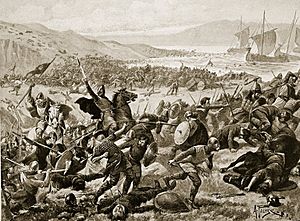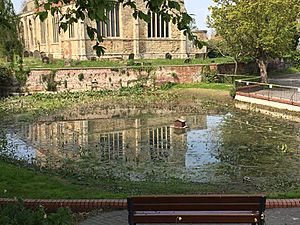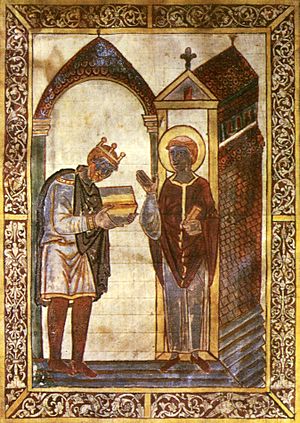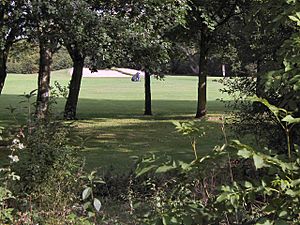Battle of Brunanburh facts for kids
Quick facts for kids Battle of Brunanburh |
|||||||
|---|---|---|---|---|---|---|---|
| Part of the Viking invasions of England | |||||||
 Alfred Pearseː The great battle of Brunanburh in 937 (Hutchinsons Story of the British Nation, 1922) |
|||||||
|
|||||||
| Belligerents | |||||||
| Kingdom of England | Kingdom of Dublin Kingdom of Alba Kingdom of Strathclyde |
||||||
| Commanders and leaders | |||||||
| Æthelstan | Olaf Guthfrithson Constantine II Owen I |
||||||
The Battle of Brunanburh was a huge fight in 937. It was between Æthelstan, the King of England, and a group of his enemies. This group included Olaf Guthfrithson, the King of Dublin; Constantine II, the King of Scotland; and Owain, the King of Strathclyde.
Some historians believe this battle was a key moment for the idea of an "English" identity. They say the people who fought there helped create the map of England we know today. This makes the Battle of Brunanburh very important for the history of England and the whole British Isles.
Before the battle, King Æthelstan had invaded Scotland in 934. This might have happened because Constantine broke a peace agreement. It became clear that to defeat Æthelstan, his enemies needed to work together. So, Olaf, Constantine, and Owen formed an alliance. In August 937, Olaf sailed from Dublin to join them. But in the battle, Æthelstan's army completely defeated them. An old poem, Battle of Brunanburh, says that never before had so many people been killed by swords in England.
Æthelstan's victory kept England united. One historian, Æthelweard, wrote around 975 that "Britain was made one, there was peace everywhere." Another historian, Alfred Smyth, called it "the greatest single battle in Anglo-Saxon history" before the Battle of Hastings. We don't know the exact place where the battle happened, but many places have been suggested.
Contents
Why the Battle Happened
After Æthelstan defeated the Vikings at York in 927, he became very powerful. Kings like Constantine of Scotland and Hywel Dda of Wales accepted Æthelstan as their leader. This happened at Eamont. Æthelstan was then known as the King of England. There was peace for a few years.
But in 934, Æthelstan invaded Scotland with a large army and navy. We're not sure why, but some say Constantine broke a peace treaty. Æthelstan's army traveled far into Scotland, but they didn't fight a big battle.
After this invasion, Æthelstan's enemies realized they had to team up to defeat him. The main leader of this new alliance was Olaf Guthfrithson, the King of Dublin. He joined forces with Constantine II, King of Scotland, and Owen, King of Strathclyde. Even though these leaders had been enemies before, they agreed to put aside their differences. Their goal was simple: to defeat Æthelstan.
In August 937, Olaf sailed from Dublin with his army to meet Constantine and Owen. This suggests the battle happened in early October. Some historians think the invading armies came into England in two groups. Constantine and Owen came from the north, and Olaf's forces joined them later.
The Battle of Brunanburh
The battle was a huge victory for Æthelstan's army. Most of what we know comes from the poem Battle of Brunanburh in the Anglo-Saxon Chronicle. Æthelstan's army marched north through Mercia. They met the invading forces at Brunanburh.
The fight lasted all day. The English army was very strong and eventually forced their enemies to break apart and run away. The poem says the English "cut through the shield-wall" and "hacked the war-lime." It also describes many soldiers lying dead, "shot over shield, taken by spears."
Æthelstan and his army chased the invaders until the end of the day, killing many enemy soldiers. Olaf escaped and sailed back to Dublin with the few soldiers he had left. Constantine also managed to escape back to Scotland. The poem says the Northmen, "disgraced in spirit, departed on Ding's Mere, in nailed boats over deep water."
The Annals of Ulster, another old record, called the battle "great, sad and horrible." It says "several thousands of Norsemen" died. Five kings and seven earls from Olaf's army were among the dead. Constantine's son also died in the battle. Many English soldiers died too, including two of Æthelstan's cousins.
What Happened After
Æthelstan's victory stopped England from breaking apart. But it didn't unite the whole island. Scotland and Strathclyde stayed independent. Historians say it's hard to overstate how important this victory was. It was a moment when "Englishness came of age."
Some historians, like Alex Woolf, say it was a "pyrrhic victory" for Æthelstan. This means he won, but at a great cost. His control over the north of England weakened. After he died, Olaf became King of Northumbria without a fight. However, by 954, the Norse lost their land in York and Northumbria.
Even though Æthelstan wanted to unite the whole island, it didn't happen. Great Britain stayed divided for centuries. But Æthelweard, writing later in the 900s, said people still called it the "great battle." He also wrote that "Britain was made one, there was peace everywhere."
Where Was Brunanburh?
The exact location of the battle is still a mystery. Historians have argued about it for centuries. More than forty places have been suggested, from southern England to Scotland. Most experts agree it was probably in northern England.
A local group called Wirral Archaeology thinks they might have found the site near Bromborough on the Wirral. They found a field with many metal objects, which could be from a tenth-century army camp. They are keeping the exact location secret to protect it.
Historian Michael Livingston believes the evidence for Bromborough is strong. He points out that Bromborough is the only place name that comes from the Old English Brunanburh. Also, there were Viking settlements in the area. The River Mersey was a common route for Vikings sailing from Ireland.
The Anglo-Saxon Chronicle poem says the battle happened "around Brunanburh." Many old texts use different names for the battle site. These include Brune, Brunandune, Et Brunnanwerc, and Bruneford. The word Brun- might refer to a person's name, a river, or an old word for a spring or stream. The endings like -burh mean "fortification" and -dun means "hill."

Some old texts mention the Humber estuary. Several sources say Olaf's fleet entered the mouth of the Humber River. One text says the armies met at "Bruneburgh on the Humber." Another says Æthelstan met pilgrims returning from Beverley as he led his army north of the Humber.
Egil's Saga, an old Icelandic story, gives more details about the landscape. It says Olaf's army was in a fortified town north of a heath. Æthelstan's camp was south of Olaf's, between a river and a forest on high ground. However, historians debate how accurate this saga is.
Many places have been suggested as the battle site, including:
- Bromborough on the Wirral
- Barnsdale, South Yorkshire
- Brinsworth, South Yorkshire
- Burnley
- Burnswark, near Lockerbie in southern Scotland
- Barton-upon-Humber in North Lincolnshire
Images for kids
-
Ancient artesian spring at Barton-upon-Humber







